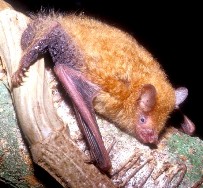Tube-nosed insectivorous bat

Common name: tube-nosed insectivorous bat
Scientific name: Murina florium
Family: Vespertilionidae
Conservation status: This species is listed as Vulnerable in Queensland (Nature Conservation Act 1992).
Description: The tube-nosed insectivorous bat has three unusual features. Firstly, it has distinctive tubular nostrils that extend from the end of its nose and point sideways. Secondly, its wing membranes are attached to the end of its outer toes and its longer than usual thumbs. And thirdly, the lower edges of its ears are deeply notched. Tube-nosed insectivorous bats weigh between 7.9-9.1 g, and have long, grizzly fur that continues from the body to cover most of the tail membrane and the bones of the wings and legs.
Habitat and distribution
This species occurs within the Wet Tropics (from Paluma to Shipton's Flat) and further north in the Iron Range on Cape York Peninsula. The limits to its distribution in Queensland are not well known. The distribution of this species extends through New Guinea and eastern Indonesia. It has been recorded from a range of rainforest types and from rainforest with emergent Eucalytpus grandis (flooded gum), at altitudes from near sea level to 1200 m.
Life history and behaviour
Apart from its unusual features, the tube-nosed insectivorous bat is also distinctive in the way it roosts. All other bat species in the Family Vespertilionidae roost by holding their wings at their side. In contrast, the tube-nosed insectivorous bat wraps its wings around itself, like a flying-fox, with its wings held away from its chest to form a cloak. Additional cover is provided by the tail membrane, which is curled over the rearwards section of wings. The function of this posture may be to prevent fur from becoming soaked with rain and reduce heat loss, and is possibly an adaptation to life in misty, mountain rainforests.
As with most micro bats, the tube-nosed insectivorous bat is nocturnally active. It has a slow, butterfly-like flight and a faint echolocation call, which is typical of species that glean insects from close surfaces and in the air at close range. It also produces a distinctive call that is of a lower frequency and longer duration than normal echolocation calls, which may have a social function.
Threatening processes
The tube-nosed insectivorous bat is threatened by inappropriate fire regimes, which can destroy their forest habitat, and habitat fragmentation. Potential threats include climate change, habitat degradation from myrtle rust and disturbance at roosts by fire ants and yellow crazy ants.
Recovery actions
- Encourage appropriate fire regimes in tube-nosed insectivorous bat habitat.
- Prevent further fragmentation of habitat for tube-nosed insectivorous bat by conserving existing habitat corridors.
- Investigate the extent of their distribution and relative impact of threats.
Related information
Churchill, S. 2009. Australian bats (second edition). Allen and Unwin, Sydney.
Richards, G.C., Hall, L.S., Helman, P.M., & Churchill, S.K. 1982. First discovery of a species of the rare tube-nosed insectivorous bat (Murina) in Australia. Australian Mammalogy 5:149-151.
Richards, G.C. Coles, R.B. & Spencer, H.J. 1995. Tube-nosed insect bat Murina florium. In: The Mammals of Australia. (Ed. Strahan, R.), pp. 510-511. Reed Books: Chatswood, NSW.
Schulz, M. & Hannah, D. 1996. Notes on the tube-nosed insect bat Murina florium (Chiroptera, Vespertilionidae) from the Atherton Tableland, north-eastern Queensland, Australia. Mammalia 60:312-316.
Schulz, M. & Hannah, D. 1998. Relative abundance, diet & roost selection of the tube-nosed insect bat, Murina florium, on the Atherton Tablelands, Australia. Wildlife Research 25:261-271.
Woinarski, J, Burbidge, A and Harrison, P. 2014. The Action Plan for Australian Mammals 2012, CSIRO Publishing, Collingwood.


